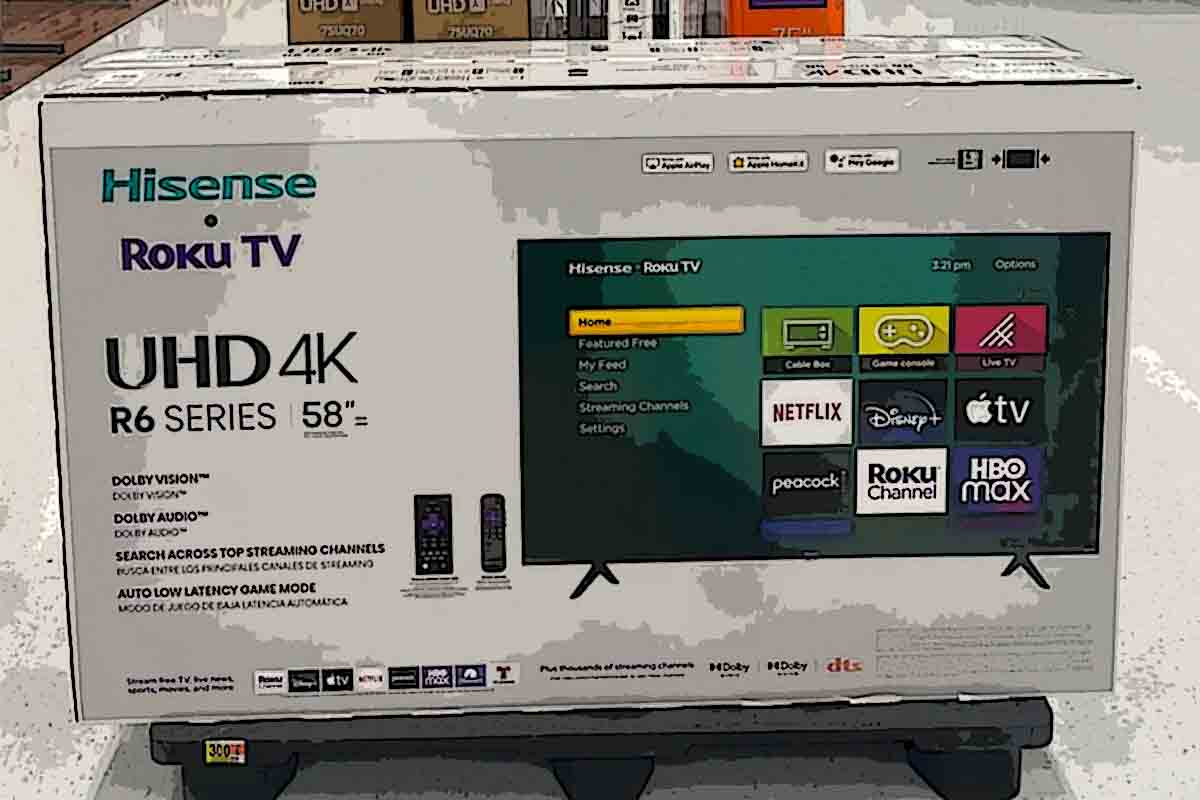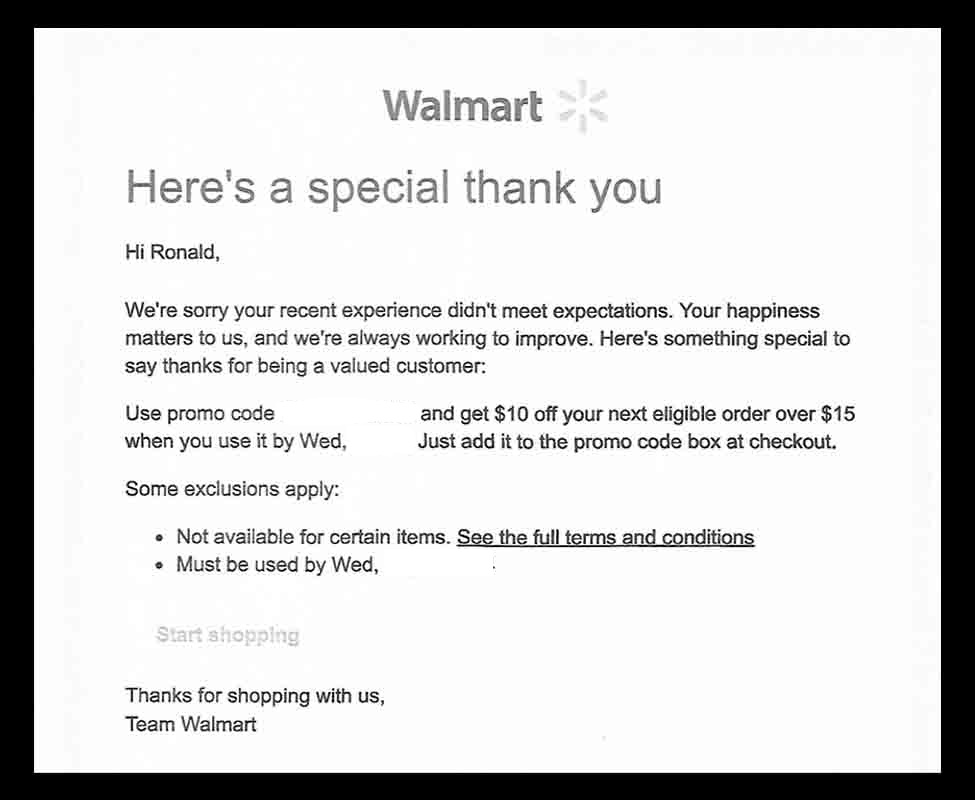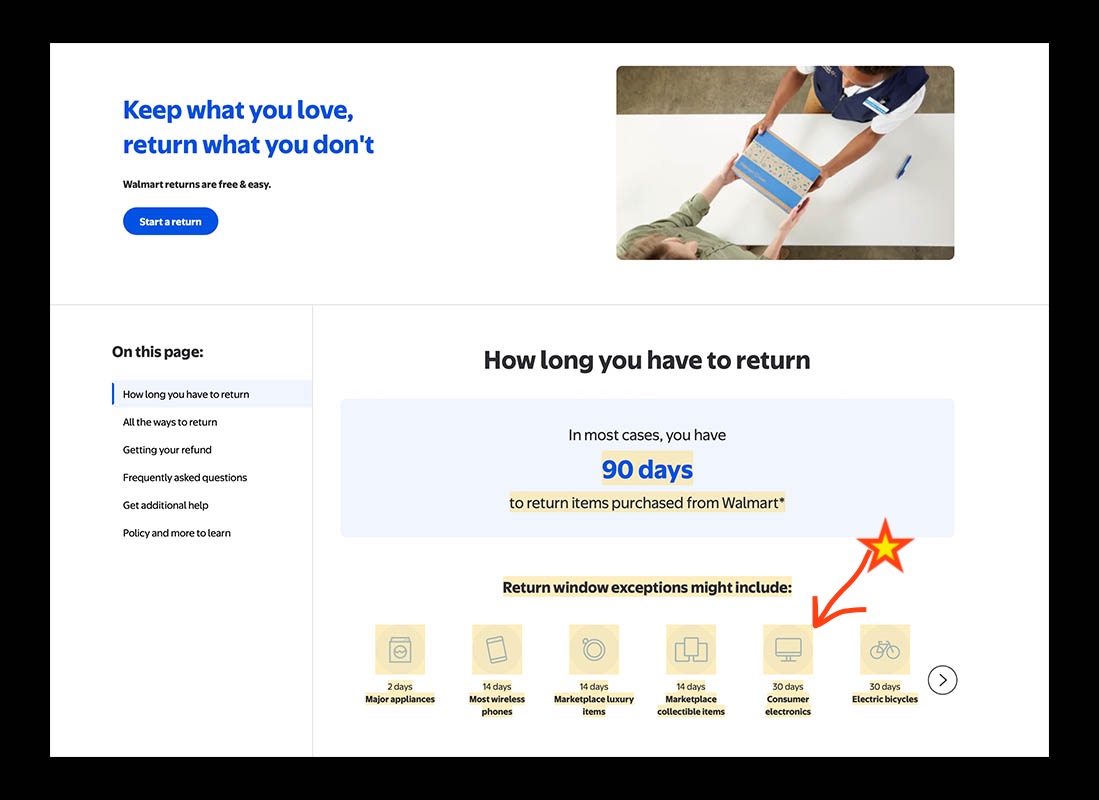Published: Updated:
After sending Ronald Brown a broken television, Walmart promised him a full refund as soon as he returned it. But months later, the retail giant adjusted its offer in a way Brown never expected. Instead of $1,297 cash, Walmart sent him a $10 online coupon and called it even.
Now, Walmart has the damaged TV and Brown’s money; all he has is that measly $10 coupon. He certainly doesn’t consider that an even exchange, and when the Consumer Rescue team heard about it, we didn’t either.
Can we ensure this Walmart customer receives the refund the company promised him, or is something else happening here?
That’s the question of the day.

Shopping for a new television online at Walmart
One morning last spring, Brown was scrolling through the Walmart website. He was in the market for a new TV. Soon he found what he considered to be a pretty good deal on a Hisense High-Definition 4K TV.
“I ordered the TV directly from the Walmart website,” Brown told me. “My receipt said it would be delivered within a week. I also paid for Walmart to send an installer to put the television on my wall.”
Just days after confirming his purchase, the TV arrived on Brown’s doorstep. He dragged the giant box inside to await the installation service. It would be a little over a week before Walmart’s approved installer showed up to mount the TV.
When the installer opened the box for the first time, he immediately noticed a large crack in the screen. He showed Brown the problem and recommended that he call Walmart right away to ask for a replacement.
Later that same day, eight days after delivery, Brown called Walmart and reported the damaged television.
“The Walmart agent promised me a full refund or a replacement TV,” Brown recalled. “I was feeling a bit soured by my online shopping experience, so I asked for my money back. She said that would be fine and scheduled a pick-up for the television.”
Then the drama really began.
Waiting and waiting for the refund from Walmart
Brown’s paper trail shows that Walmart confirmed its shipping company would pick up the damaged TV a few days later. On that day, Brown stayed home to hand over the box, but no one ever showed up.
“I called Walmart at the end of the day to report that the TV was still at my house,” Brown explained. “That agent rescheduled the pick-up for the following week.”
When the new date for pick-up arrived, Brown once again stayed at home. And once again, the entire day went by with no sign of the shipping company.
After wasting two full days waiting for Walmart to send someone to take the damaged TV away, Brown was irritated. He reported the absentee driver again and asked that his refund be processed.
“The Walmart agent said she couldn’t process the refund until I returned the TV,” Brown says. “But I couldn’t return the television on my own so I was stuck.”
For the next six weeks, the annoyingly obtrusive box sat in Brown’s living room awaiting pickup. Finally, after more calls and emails, Walmart arranged for a different shipping company to come for the damaged TV.
This time, a driver arrived before lunchtime and promptly removed the cracked television from Brown’s house. After waiting nearly two months for his refund, Brown assumed Walmart would quickly return his $1,297.
He was wrong. Very wrong.
“Walmart can’t send a refund, but we can send you a coupon.”
Ten days passed before Brown began calling Walmart again to ask about his refund. An agent told him she wasn’t sure why his $1,297 hadn’t been returned yet, but she would escalate his complaint.
A few days later, Brown was initially pleased to see an email from Walmart. He hoped it would be confirmation that his refund had been processed.
It definitely wasn’t.
Instead, Brown was flabbergasted to learn Walmart intended to substitute a $10 shopping coupon in place of his $1,297 cash refund. To add insult to injury, the coupon had highly restrictive terms and a fast approaching (60-day) expiration date.
Not that Brown intended to settle for the coupon anyway.

In a flash, Brown was back on the phone. This time, an agent had a direct explanation for him: Walmart wouldn’t ever be issuing a refund for the damaged TV.
“They [Walmart agent and supervisor] told me to contact Hisense directly,” Brown told me. “Why would I have to ask the TV manufacturer for a refund when Walmart delivered a cracked TV?”
Of course, Walmart shouldn’t have been directing its customer to the manufacturer for a damaged-at-delivery product. However, it was clear to Brown that after three months of going round and round waiting for his refund, Walmart didn’t intend to budge.
That’s when he sent his request for help to our advocacy team.
Can our advocacy team rescue this consumer?
When I reviewed Brown’s paper trail, I shared his outrage that Walmart expected a $10 shopping coupon to be a satisfactory replacement for a refund. However, I also noticed some missteps Brown had taken that opened the door for Walmart’s unusual stance.
Specifically, he had not photographed the crack on the day the installer discovered it — or ever. So, three months later, when he contacted Consumer Rescue, he had no evidence that the TV was damaged.
📬 Subscribe to:
Tales from Consumer Advocacy Land
Real stories. Real rescues. Real advice.
Join thousands of smart travelers and savvy consumers who already subscribe to Tales from Consumer Advocacy Land — the friendly weekly newsletter from Michelle Couch-Friedman, founder of Consumer Rescue. It's filled with helpful consumer guidance, insider tips, and links to all of our latest articles.

Even worse, his written correspondence with various Walmart employees made no mention that the TV was returned because it was cracked. Based on the emails alone, it wasn’t clear why the television was being returned.
However, the most significant problem that led to Walmart’s ultimate withdrawal of the refund offer was the TV’s return date. It took almost two months after the television was delivered before Walmart finally removed it from Brown’s home. Although Walmart’s unreliable shipping company created the problem, after the second failed pickup, a frustrated Brown waited several weeks before following up with the retailer.
Ultimately, if a Walmart customer doesn’t return a defective electronic product within 30 days, the manufacturer is responsible for repairs or returns. That policy technically allowed Walmart to refuse responsibility for the damaged product.

I didn’t agree that this was fair to Brown. He had called Walmart immediately to arrange pickup and spent two days sitting at home waiting. Not only that, but Walmart had eventually taken the TV, so it should have processed his refund.
It was time for me to ask our Walmart executive contact why the company hadn’t returned his money.
Related: How to quickly lose $1,100 in the Walmart Mystery Shopping scam
Good news: Walmart will refund this customer
In the end, the executive team at Walmart agreed with me and processed Brown’s refund.
He now has his money back and is browsing for a new TV. Something tells me he won’t be making any more big-ticket purchases online.
It was a nightmarish three months trying to get my money back. If we were wealthy, I would have just chalked it up as a learning opportunity. But [we aren’t] and this has a huge impact on us.
Thank you again, we appreciate your help very much.
Ron Brown
You’re very welcome, Ron. No consumer, wealthy or not, should have to chalk up $1,297 to a learning experience. That’s why we do what we do here every day at Consumer Rescue. 🛟⛑️
Related: Would Walmart ban a customer for returning two cans of cat food?
Consumer Rescue’s tips for trouble-free online shopping
Here at Consumer Rescue, we often receive requests for help from online shoppers who have experienced a problem after an internet purchase. Many of these issues can be entirely avoided by following a few simple rules.
1. Only make purchases from established, well-known companies
Not every online storefront that you see advertising on social media channels or in the Google search results is legitimate or reputable. In fact, I would go so far as to say that scammers are behind a large portion of websites peddling products. I know because I see the troubling aftermath of these looking-for-a-bargain shopping sprees.
Remember, anyone can set up a website and scammers often do. Stick to established, well-known companies with proven track records to reduce your chance of landing in a shopping fiasco you can’t escape.
2. Read the terms of purchase before completing the transaction
Before making that online purchase, make sure you read the company’s terms. Specifically, you want to know what the return policy is and the ease of the process.
For heavy, big-ticket items, this is crucial, because if the terms say the consumer must arrange the pickup and return on their own (even if the product is damaged), that should be a deal breaker. Reputable companies stand behind their products and arrange pickup and return if the items arrive damaged.
Note: A recent trend I’ve seen begins with a consumer purchasing something they’ve seen advertised on Facebook. When the product arrives (after an extended shipping time), it is not as the ad implied. Only then does the purchaser discover that the company is based in China, and any returns are the customer’s responsibility. As you can guess, in most cases, the shipping costs outweigh the value of the unwanted product.
Keep in mind that Facebook ads are very cheap, and anyone, and I do mean anyone, can buy one. Never purchase anything from Facebook unless you thoroughly vet the company along with its return policy – because Facebook doesn’t. (See: Think you got scammed by a Facebook ad? You’re not alone)
3. Take a screenshot of the description of the item
No matter where you’re shopping online, it’s always a good idea to take a screenshot of the description of the product as it appeared at the time of purchase. That way if there is a discrepancy when it arrives, you’ll have proof.
4. Inspect the product as soon as you receive it and photograph damage
I’ve had consumers contact me long after they received a product, complaining that the item was damaged or not as described. The problem? They didn’t unbox the item until weeks or, in some cases, months after receiving it. This happens more frequently around the holidays when consumers may make purchases in advance and store the boxes away for gifting later.
You must inspect online purchases within the time frame noted in the company’s return policy. Open the box and have a look, or you could miss the deadline for reporting a damaged product and get stuck with it.
Don’t forget to take a photo of the damage as well.
5. Follow the return instructions and promptly send back damaged products
Lastly, ensure that you understand the return instructions and follow them. Some companies, including Amazon and Walmart, require that customers get approval before sending the product back. Then there is a deadline for the product to be returned.
Always mind the expiration date on your return approval.
Ask Consumer Rescue for help
It’s easier than ever to shop online and have big-ticket items quickly shipped right to your home. But if something goes wrong, consumers often discover it’s nearly impossible to reach someone who can fix the problem. Unfortunately, in the age of AI-powered customer service, finding a friendly, helpful human agent is more difficult than ever.
And it’s only going to get worse. Here at Consumer Rescue, we know this and we have the answer.
If you need assistance finding a real person at a company, you can “Just ask Meera.” She’s your personal executive contact finder. Meera can give you the name and email of someone whom our team knows can help you.
Of course, you always have one more secret weapon in your problem-solving arsenal – the Consumer Rescue advocacy team.
We’re dedicated to rescuing consumers from their customer service battles; always carefully investigating and mediating the cases we receive to reach positive and fair resolutions. Our consumer advocacy is fast, friendly, and always free of charge. (Michelle Couch-Friedman, Founder of Consumer Rescue)




